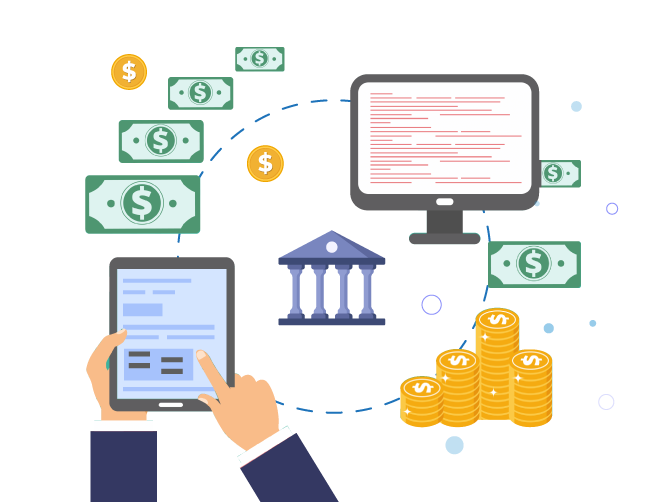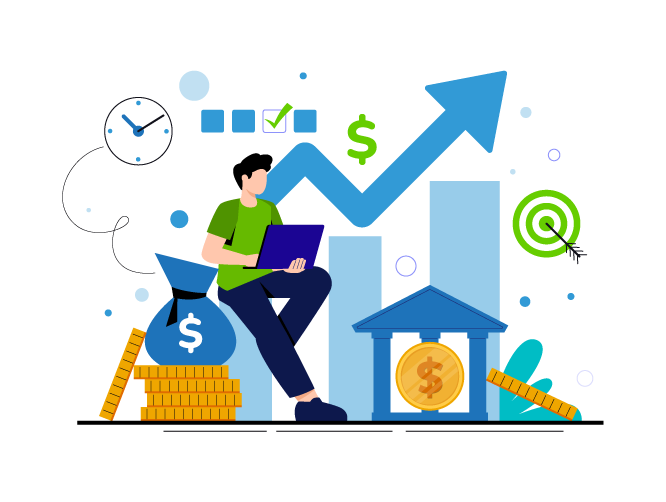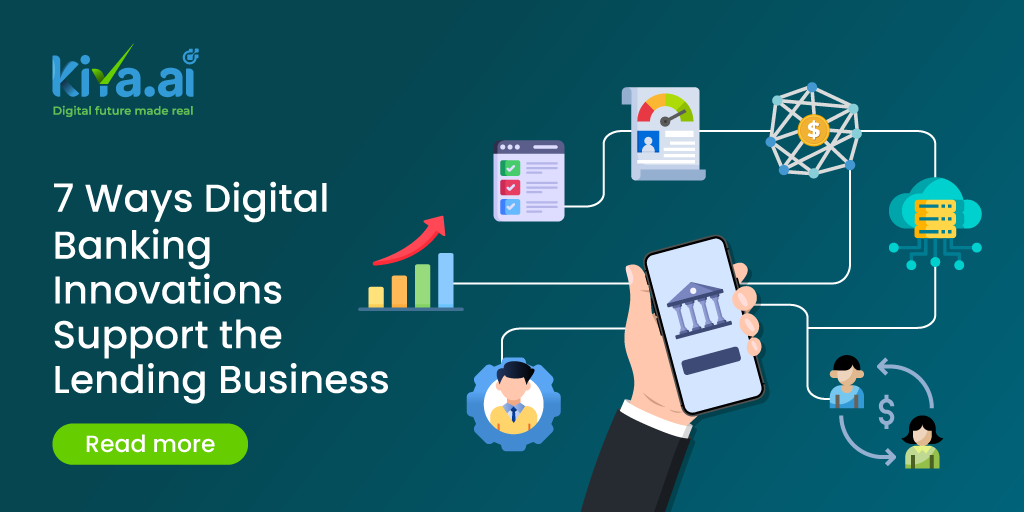7 Ways Digital Banking Innovations Support the Lending Business

Financial inclusion is one of the cornerstones around which every modern and ever-growing economy is built. This involves offering individuals and businesses across the social spectrum the opportunity to obtain financial services and products from ethical and trustworthy lenders at a fair price and in the quickest possible manner. While there has been a surge in commitment to financial inclusion around the world in recent years, with the government establishing it as a top priority in its economic legislation, there is still a lot to be done as access to credit from official sources remains an obstacle for a significant portion of the population. In such a socioeconomic context, digital lending becomes crucial in the establishment of multiple pathways that may cater to the financial demands of the underprivileged communities.Â
As digital transformation accelerates across various industries, with the market expected to reach USD 1548.9 billion by 2027, the financial sector is on the hunt for strategies to capitalise on emerging technologies for promoting automation and digitalisation of lending operations. To assist the global financial sector in achieving its business goals, FinTech providers have created robust and improved lending systems with faster processing and little to no documentation.
Here are the 7 Ways digital lending solutions can support your lending business and help you thrive:
1. Automated loan origination process:

Digital lending has revolutionised the traditional lending industry by incorporating various components that reduce costs and improve efficiency. One of the key components is the automation of the loan origination process, including underwriting, which can be greatly enhanced through machine learning algorithms for assessing an applicant’s creditworthiness.Â
By automating the underwriting process using machine learning, digital lending solutions offer several benefits such as;Â Â
Efficiency
Automated underwriting is much faster than traditional manual underwriting, allowing lenders to process a higher volume of loan applications in a shorter time.
Consistency
Machine learning algorithms apply consistent and unbiased criteria to evaluate applicants, reducing the risk of human bias or errors in decision-making.
Risk Management
Advanced lending solutions better assess credit risk, potentially leading to reduced default rates and improved portfolio performance.
Cost Reduction
Automation reduces the need for a large team of underwriters, which significantly cuts operational costs for lenders.
In nutshell, an automated loan origination process offers lending businesses a competitive edge by improving efficiency, maintaining consistency, reducing operational costs, enhancing customer satisfaction, and mitigating risks. It allows for quicker, data-driven decision-making while ensuring compliance with regulatory requirementsÂ
2. Smart use of AI can help you assist your applicant’s credit worthiness:

AI’s ability to process vast amounts of data, detect patterns, and make predictions based on historical and real-time data enables lenders to make more informed decisions regarding an applicant’s creditworthiness. By combining these capabilities, AI enhances the accuracy and efficiency of the credit evaluation process while reducing the risk of default and fraud, ultimately benefiting both lenders and borrowers.
• Digital Verification: AI revolutionises the verification process through advanced APIs, digital visualisation, and integration with platforms like DigiLocker. This includes leveraging account aggregation, implementing liveliness cheques, and employing challenge-response authentication for seamless and secure digital onboarding.
• Digital Evaluation: AI plays a crucial role in evaluating and underwriting submitted documents to assess creditworthiness. The credit scoring model employed is a hybrid, combining data both with and without traditional credit scores. This model captures intricate patterns related to spending, payment behaviour, and credit payments. The result is a comprehensive underwriting process that ensures a thorough evaluation of creditworthiness and accurate provision assessments.
• Alternative Data Sources: AI analyses an applicant’s online presence, including social media activity and online behaviour, to gain insights into their lifestyle, financial habits, and potential risks. Along with this, it also helps the lenders to assess an applicant’s financial health by analysing bank transaction data, identifying income sources, spending patterns, and financial stability.
• Advanced Risk Assessment: AI uses machine learning algorithms to build predictive models that evaluate an applicant’s credit risk based on a wide range of data points, including credit history, income, employment history, and alternative data. It also has the potential to assess an applicant’s behaviour and predict their likelihood of repayment based on factors like payment history, debt utilisation, and other financial behaviours.
• Fraud Detection: AI detects unusual patterns or anomalies in loan applications and transactions, helping to identify potential fraud or malicious activity.
• Real-Time Monitoring: AI can continuously monitor an applicant’s credit behaviour, alerting lenders to any negative changes or delinquencies. Along with this, for existing borrowers, AI can monitor transactions and financial behaviour in real time to detect early signs of financial distress or fraud.
• Multi-channel support: AI can be leveraged across various channels, including mobile banking, online banking, kiosks, and even emerging technologies like the metaverse, to streamline the lending process.

3. Blockchain and Smart Contracts to Reduce The Cost of Small Loans:

The integration of blockchain technology and smart contracts into the digital lending landscape holds tremendous potential, especially in reducing the cost associated with small loans. Blockchain introduces a secure and immutable ledger for all loan transactions, significantly diminishing the risks of fraud, errors, and disputes. Thanks to its decentralised structure, blockchain facilitates the storage of borrower and lender data, effectively mitigating the probability of data breaches. Consequently, this integration translates into lower expenditures on cybersecurity and data protection.
Smart contracts, functioning as self-executing agreements with pre-coded loan terms, offer automation capabilities throughout the loan origination process. This includes seamless management of disbursement, interest computation, and repayment. Furthermore, smart contracts enable swift loan approval and disbursement upon meeting predefined conditions, streamlining the traditionally cumbersome loan processing timeline.
These intelligent contracts find application in both simple and complex loan structures, such as consortium lending systems where multiple lenders collaborate to finance a single borrower. In this collaborative approach, lending banks formally unite through an inter-sae agreement to address the credit needs of a borrower, showcasing the versatility and efficiency that blockchain and smart contracts bring to the digital lending landscape.
4. Cloud Infrastructure:
Storing vast amounts of data securely and accessing it quickly is crucial in the lending industry. Cloud infrastructure provides scalable and reliable data storage solutions, ensuring that loan-related data is readily available while also reducing the risk of data loss. Today, many Fintech providers offer tools and services designed to help businesses meet regulatory requirements, making it easier for lending companies to adhere to financial industry regulations.
5. Peer-to-peer (P2P) lending modules:
Peer-to-peer (P2P) lending promotes financial inclusion. By integrating Peer-to-peer modules, lending businesses can reach a broader range of borrowers. This includes individuals, small businesses, and other entities that may not have access to traditional financial institutions. It results in increased loan origination volume, allowing lending businesses to scale their operations and generate more revenue.
6. Hyper personalisation to filter and target the correct audience:
Digital lending indeed facilitates hyper-personalisation, allowing lending institutions to filter and target the correct audience with highly tailored loan products and marketing strategies. By understanding borrowers’ financial behaviour, lending institutions get to identify opportunities for cross-selling additional financial products or services, such as credit cards, insurance, or investment options. Personalised offers can be extended to borrowers based on their individual financial needs and interests. This primary leads to higher customer satisfaction and conversion rates.
7. Equitable growth across the board (Expanding inclusion):

Enhancing financial inclusion is instrumental in reducing poverty and promoting equitable economic growth. Access to credit and financial services empowers individuals and small businesses to invest in income-generating activities, thereby contributing to economic development. The expansion of financial inclusion is not only a means to promote economic growth and poverty reduction but also an opportunity to harness technology and innovation to make financial services more accessible and efficient.
The inclusion plan focuses on risk management, investor protection, and the use of multiple channels to reach individuals beyond traditional banking. By embracing these strategies, financial institutions can make a positive impact on both society and the economy. It is safe to say that by embracing digital banking innovations, the lending business can not only reduce costs associated with loan management but also provide a more efficient and accessible lending process for borrowers, ultimately supporting the growth and competitiveness of lending institutions.
Now let’s see how KiyaAi’s digital banking solutions can help the industry! (Conclusion)
KiyaAi’s comprehensive digital banking approach demonstrates a strong commitment to addressing the diverse needs of the global financial industry. Our innovative offerings encompass a wide range of capabilities that support not only financial institutions but also the borrowers and stakeholders involved in the lending process.
Wondering HOW?
Well,
- KiyaAi provides diverse channels, including mobile banking apps, online banking capabilities, chatbots, and even engagement in the metaverse, to extend the reach of loan origination and servicing. This broadens access to financial services for a wide range of customers.Â
- KiyaAi‘s digital loan origination solution leverages AI-based tools to automate the entire origination process, from campaign management to data capture, API integration for credit scoring, risk assessment, and fraud detection. This streamlines the lending process, making it efficient and user-friendly.
- Our advanced analytics capabilities extend to areas such as Expected Credit Loss (ECL) statements, risk management, and asset liability management (ALM). These tools help financial institutions gain insights into their loan portfolios, funding requirements, and non-performing assets.Â
- By making data readily accessible and drawing inferences from algorithms, KiyaAi allows you to enhance the quality of lending decisions.Â
- Our cutting-edge solutions allow borrowers to track the progress of their loans, while enabling lending firms and stakeholders to gain insights into the loan processing stage.
- We help you maintain transparency, while aligning well with the evolving needs of the global banking & finance industry. Â

Financial inclusion is one of the cornerstones around which every modern and ever-growing economy is built. This involves offering individuals and businesses across the social spectrum the opportunity to obtain financial services and products from ethical and trustworthy lenders at a fair price and in the quickest possible manner. While there has been a surge in commitment to financial inclusion around the world in recent years, with the government establishing it as a top priority in its economic legislation, there is still a lot to be done as access to credit from official sources remains an obstacle for a significant portion of the population. In such a socioeconomic context, digital lending becomes crucial in the establishment of multiple pathways that may cater to the financial demands of the underprivileged communities.Â
As digital transformation accelerates across various industries, with the market expected to reach USD 1548.9 billion by 2027, the financial sector is on the hunt for strategies to capitalise on emerging technologies for promoting automation and digitalisation of lending operations. To assist the global financial sector in achieving its business goals, FinTech providers have created robust and improved lending systems with faster processing and little to no documentation.
Here are the 7 Ways digital lending solutions can support your lending business and help you thrive:
1. Automated loan origination process:

Digital lending has revolutionised the traditional lending industry by incorporating various components that reduce costs and improve efficiency. One of the key components is the automation of the loan origination process, including underwriting, which can be greatly enhanced through machine learning algorithms for assessing an applicant’s creditworthiness.Â
By automating the underwriting process using machine learning, digital lending solutions offer several benefits such as;Â Â
Efficiency
Automated underwriting is much faster than traditional manual underwriting, allowing lenders to process a higher volume of loan applications in a shorter time.
Consistency
Machine learning algorithms apply consistent and unbiased criteria to evaluate applicants, reducing the risk of human bias or errors in decision-making.
Risk Management
Advanced lending solutions better assess credit risk, potentially leading to reduced default rates and improved portfolio performance.
Cost Reduction
Automation reduces the need for a large team of underwriters, which significantly cuts operational costs for lenders.
In nutshell, an automated loan origination process offers lending businesses a competitive edge by improving efficiency, maintaining consistency, reducing operational costs, enhancing customer satisfaction, and mitigating risks. It allows for quicker, data-driven decision-making while ensuring compliance with regulatory requirementsÂ
2. Smart use of AI can help you assist your applicant’s credit worthiness:

AI’s ability to process vast amounts of data, detect patterns, and make predictions based on historical and real-time data enables lenders to make more informed decisions regarding an applicant’s creditworthiness. By combining these capabilities, AI enhances the accuracy and efficiency of the credit evaluation process while reducing the risk of default and fraud, ultimately benefiting both lenders and borrowers.
• Digital Verification: AI revolutionises the verification process through advanced APIs, digital visualisation, and integration with platforms like DigiLocker. This includes leveraging account aggregation, implementing liveliness cheques, and employing challenge-response authentication for seamless and secure digital onboarding.
• Digital Evaluation: AI plays a crucial role in evaluating and underwriting submitted documents to assess creditworthiness. The credit scoring model employed is a hybrid, combining data both with and without traditional credit scores. This model captures intricate patterns related to spending, payment behaviour, and credit payments. The result is a comprehensive underwriting process that ensures a thorough evaluation of creditworthiness and accurate provision assessments.
• Alternative Data Sources: AI analyses an applicant’s online presence, including social media activity and online behaviour, to gain insights into their lifestyle, financial habits, and potential risks. Along with this, it also helps the lenders to assess an applicant’s financial health by analysing bank transaction data, identifying income sources, spending patterns, and financial stability.
• Advanced Risk Assessment: AI uses machine learning algorithms to build predictive models that evaluate an applicant’s credit risk based on a wide range of data points, including credit history, income, employment history, and alternative data. It also has the potential to assess an applicant’s behaviour and predict their likelihood of repayment based on factors like payment history, debt utilisation, and other financial behaviours.
• Fraud Detection: AI detects unusual patterns or anomalies in loan applications and transactions, helping to identify potential fraud or malicious activity.
• Real-Time Monitoring: AI can continuously monitor an applicant’s credit behaviour, alerting lenders to any negative changes or delinquencies. Along with this, for existing borrowers, AI can monitor transactions and financial behaviour in real time to detect early signs of financial distress or fraud.
• Multi-channel support: AI can be leveraged across various channels, including mobile banking, online banking, kiosks, and even emerging technologies like the metaverse, to streamline the lending process.

3. Blockchain and Smart Contracts to Reduce The Cost of Small Loans:

The integration of blockchain technology and smart contracts into the digital lending landscape holds tremendous potential, especially in reducing the cost associated with small loans. Blockchain introduces a secure and immutable ledger for all loan transactions, significantly diminishing the risks of fraud, errors, and disputes. Thanks to its decentralised structure, blockchain facilitates the storage of borrower and lender data, effectively mitigating the probability of data breaches. Consequently, this integration translates into lower expenditures on cybersecurity and data protection.
Smart contracts, functioning as self-executing agreements with pre-coded loan terms, offer automation capabilities throughout the loan origination process. This includes seamless management of disbursement, interest computation, and repayment. Furthermore, smart contracts enable swift loan approval and disbursement upon meeting predefined conditions, streamlining the traditionally cumbersome loan processing timeline.
These intelligent contracts find application in both simple and complex loan structures, such as consortium lending systems where multiple lenders collaborate to finance a single borrower. In this collaborative approach, lending banks formally unite through an inter-sae agreement to address the credit needs of a borrower, showcasing the versatility and efficiency that blockchain and smart contracts bring to the digital lending landscape.
4. Cloud Infrastructure:
Storing vast amounts of data securely and accessing it quickly is crucial in the lending industry. Cloud infrastructure provides scalable and reliable data storage solutions, ensuring that loan-related data is readily available while also reducing the risk of data loss. Today, many Fintech providers offer tools and services designed to help businesses meet regulatory requirements, making it easier for lending companies to adhere to financial industry regulations.
5. Peer-to-peer (P2P) lending modules:
Peer-to-peer (P2P) lending promotes financial inclusion. By integrating Peer-to-peer modules, lending businesses can reach a broader range of borrowers. This includes individuals, small businesses, and other entities that may not have access to traditional financial institutions. It results in increased loan origination volume, allowing lending businesses to scale their operations and generate more revenue.
6. Hyper personalisation to filter and target the correct audience:
Digital lending indeed facilitates hyper-personalisation, allowing lending institutions to filter and target the correct audience with highly tailored loan products and marketing strategies. By understanding borrowers’ financial behaviour, lending institutions get to identify opportunities for cross-selling additional financial products or services, such as credit cards, insurance, or investment options. Personalised offers can be extended to borrowers based on their individual financial needs and interests. This primary leads to higher customer satisfaction and conversion rates.
7. Equitable growth across the board (Expanding inclusion):

Enhancing financial inclusion is instrumental in reducing poverty and promoting equitable economic growth. Access to credit and financial services empowers individuals and small businesses to invest in income-generating activities, thereby contributing to economic development. The expansion of financial inclusion is not only a means to promote economic growth and poverty reduction but also an opportunity to harness technology and innovation to make financial services more accessible and efficient.
The inclusion plan focuses on risk management, investor protection, and the use of multiple channels to reach individuals beyond traditional banking. By embracing these strategies, financial institutions can make a positive impact on both society and the economy. It is safe to say that by embracing digital banking innovations, the lending business can not only reduce costs associated with loan management but also provide a more efficient and accessible lending process for borrowers, ultimately supporting the growth and competitiveness of lending institutions.
Now let’s see how KiyaAi’s digital banking solutions can help the industry! (Conclusion)
KiyaAi’s comprehensive digital banking approach demonstrates a strong commitment to addressing the diverse needs of the global financial industry. Our innovative offerings encompass a wide range of capabilities that support not only financial institutions but also the borrowers and stakeholders involved in the lending process.
Wondering HOW?
Well,
- KiyaAi provides diverse channels, including mobile banking apps, online banking capabilities, chatbots, and even engagement in the metaverse, to extend the reach of loan origination and servicing. This broadens access to financial services for a wide range of customers.Â
- KiyaAi‘s digital loan origination solution leverages AI-based tools to automate the entire origination process, from campaign management to data capture, API integration for credit scoring, risk assessment, and fraud detection. This streamlines the lending process, making it efficient and user-friendly.
- Our advanced analytics capabilities extend to areas such as Expected Credit Loss (ECL) statements, risk management, and asset liability management (ALM). These tools help financial institutions gain insights into their loan portfolios, funding requirements, and non-performing assets.Â
- By making data readily accessible and drawing inferences from algorithms, KiyaAi allows you to enhance the quality of lending decisions.Â
- Our cutting-edge solutions allow borrowers to track the progress of their loans, while enabling lending firms and stakeholders to gain insights into the loan processing stage.
- We help you maintain transparency, while aligning well with the evolving needs of the global banking & finance industry. Â
